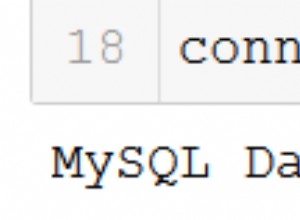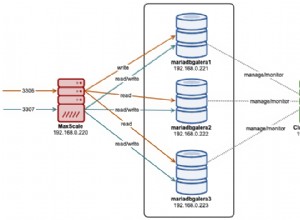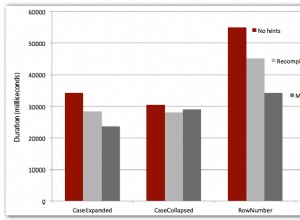Questo articolo elenca l'SQL DELETE sintassi, come implementato da vari sistemi di gestione di database (DBMS). La sintassi è elencata esattamente come l'ha elencata ogni fornitore sul proprio sito Web. Fare clic sul collegamento applicabile per visualizzare maggiori dettagli sulla sintassi per un particolare fornitore.
I DBMS coperti sono MySQL, SQL Server, PostgreSQL e Oracle Database.
MySQL
Dal manuale di riferimento di MySQL 5.7.
Sintassi a tabella singola:
DELETE [LOW_PRIORITY] [QUICK] [IGNORE] FROMtbl_name[PARTITION (partition_name,...)] [WHEREwhere_condition] [ORDER BY ...] [LIMITrow_count]
Sintassi a più tabelle:
DELETE [LOW_PRIORITY] [QUICK] [IGNORE]
tbl_name[.*] [, tbl_name[.*]] ...
FROM table_references
[WHERE where_condition] Oppure:
DELETE [LOW_PRIORITY] [QUICK] [IGNORE]
FROM tbl_name[.*] [, tbl_name[.*]] ...
USING table_references
[WHERE where_condition] SQL Server
Dal riferimento Transact-SQL:
[ WITH <common_table_expression> [ ,...n ] ]
DELETE
[ TOP ( expression ) [ PERCENT ] ]
[ FROM ]
{ { table_alias
| <object>
| rowset_function_limited
[ WITH ( table_hint_limited [ ...n ] ) ] }
| @table_variable
}
[ <OUTPUT Clause> ]
[ FROM table_source [ ,...n ] ]
[ WHERE { <search_condition>
| { [ CURRENT OF
{ { [ GLOBAL ] cursor_name }
| cursor_variable_name
}
]
}
}
]
[ OPTION ( <Query Hint> [ ,...n ] ) ]
[; ]
<object> ::=
{
[ server_name.database_name.schema_name.
| database_name. [ schema_name ] .
| schema_name.
]
table_or_view_name
} PostgreSQL
Dal manuale di PostgreSQL 9.5:
[ WITH [ RECURSIVE ] with_query [, ...] ]
DELETE FROM [ ONLY ] table_name [ * ] [ [ AS ] alias ]
[ USING using_list ]
[ WHERE condition | WHERE CURRENT OF cursor_name ]
[ RETURNING * | output_expression [ [ AS ] output_name ] [, ...] ] Database Oracle
Dalla documentazione online di Oracle Database 12c Versione 1 (12.1):
DELETE [ hint ]
[ FROM ]
{ dml_table_expression_clause
| ONLY (dml_table_expression_clause)
} [ t_alias ]
[ where_clause ]
[ returning_clause ]
[error_logging_clause]; DML_table_expression_clause::=
{ [ schema. ]
{ table
[ partition_extension_clause
| @ dblink
]
| { view | materialized view } [ @ dblink ]
}
| ( subquery [ subquery_restriction_clause ] )
| table_collection_expression
} clausola_estensione_partizione::=
{ PARTITION (partition)
| PARTITION FOR (partition_key_value [, partition_key_value]...)
| SUBPARTITION (subpartition)
| SUBPARTITION FOR (subpartition_key_value [, subpartition_key_value]...)
} subquery_restriction_clause::=
WITH { READ ONLY
| CHECK OPTION
} [ CONSTRAINT constraint ] table_collection_expression::=
TABLE (collection_expression) [ (+) ]
dove_clausola::=
WHERE condition
clausola_ritorno ::=
{ RETURN | RETURNING } expr [, expr ]...
INTO data_item [, data_item ]... error_logging_clause ::=
LOG ERRORS
[ INTO [schema.] table ]
[ (simple_expression) ]
[ REJECT LIMIT { integer | UNLIMITED } ] Informazioni su DELETE Dichiarazione
Il DELETE istruzione è un'istruzione DML (Data Manipolazione Language) che rimuove le righe specificate da una tabella.
Il CANCELLA l'istruzione elimina le righe che soddisfano WHERE clausola dalla tabella specificata. Se il DOVE la clausola è assente, tutte le righe della tabella verranno eliminate, lasciando la tabella vuota.
Suggerimento
Il TRUNCATE istruzione (o, nel caso di SQL Server, la TRUNCATE TABLE ) è simile a DELETE dichiarazione senza WHERE clausola; tuttavia, TRUNCATE è più veloce e utilizza meno risorse del registro delle transazioni e del sistema.




